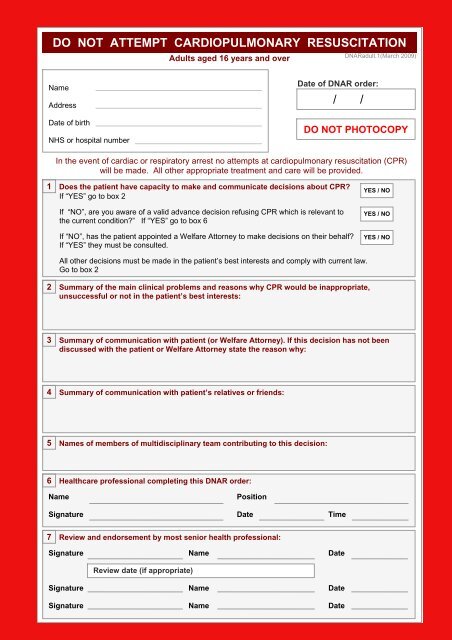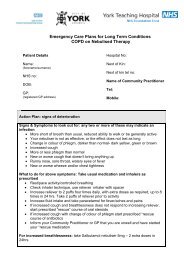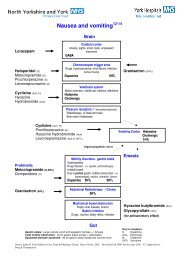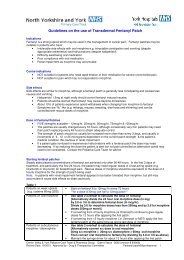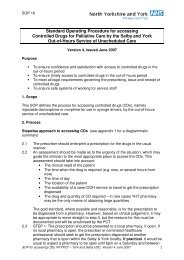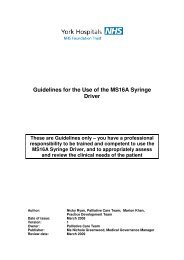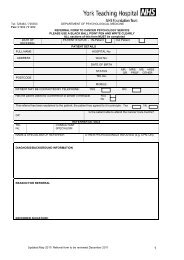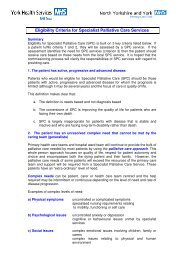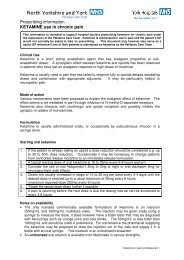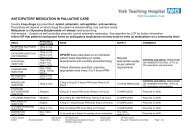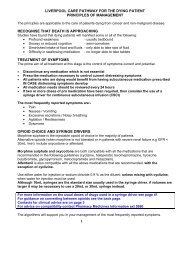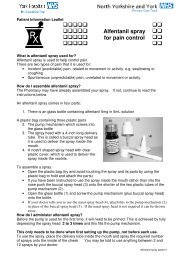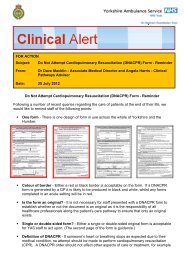do not attempt cardiopulmonary resuscitation - Palliative Care ...
do not attempt cardiopulmonary resuscitation - Palliative Care ...
do not attempt cardiopulmonary resuscitation - Palliative Care ...
You also want an ePaper? Increase the reach of your titles
YUMPU automatically turns print PDFs into web optimized ePapers that Google loves.
DO NOT ATTEMPT CARDIOPULMONARY RESUSCITATION<br />
Adults aged 16 years and over<br />
DNARadult.1(March 2009)<br />
Name<br />
Address<br />
Date of birth<br />
NHS or hospital number<br />
Date of DNAR order:<br />
/ /<br />
DO NOT PHOTOCOPY<br />
In the event of cardiac or respiratory arrest no <strong>attempt</strong>s at <strong>cardiopulmonary</strong> <strong>resuscitation</strong> (CPR)<br />
will be made. All other appropriate treatment and care will be provided.<br />
1<br />
Does the patient have capacity to make and communicate decisions about CPR?<br />
If “YES” go to box 2<br />
If “NO”, are you aware of a valid advance decision refusing CPR which is relevant to<br />
the current condition?” If “YES” go to box 6<br />
If “NO”, has the patient appointed a Welfare Attorney to make decisions on their behalf?<br />
If “YES” they must be consulted.<br />
YES / NO<br />
YES / NO<br />
YES / NO<br />
All other decisions must be made in the patient’s best interests and comply with current law.<br />
Go to box 2<br />
2<br />
Summary of the main clinical problems and reasons why CPR would be inappropriate,<br />
unsuccessful or <strong>not</strong> in the patient’s best interests:<br />
3<br />
Summary of communication with patient (or Welfare Attorney). If this decision has <strong>not</strong> been<br />
discussed with the patient or Welfare Attorney state the reason why:<br />
4<br />
Summary of communication with patient’s relatives or friends:<br />
5<br />
Names of members of multidisciplinary team contributing to this decision:<br />
6<br />
Healthcare professional completing this DNAR order:<br />
Name<br />
Position<br />
Signature Date Time<br />
7<br />
Review and en<strong>do</strong>rsement by most senior health professional:<br />
Signature Name Date<br />
Review date (if appropriate)<br />
Signature Name Date<br />
Signature Name Date
This form should be completed legibly in black ball point ink<br />
All sections should be completed<br />
• The patient’s full name, date of birth and address should be written clearly.<br />
• The date of writing the order should be entered.<br />
• This order will be regarded as “INDEFINITE” unless it is clearly cancelled.<br />
• The order should be reviewed whenever clinically appropriate, the patient expressly wishes<br />
it or whenever the patient is transferred within the community i.e. (Community Hospital,<br />
Nursing home, Hospice, Patients Home or the Acute Trust Hospital)<br />
• If the decision is cancelled the form should be crossed through with 2 diagonal lines in black<br />
ball-point ink and “CANCELLED” written clearly between them, signed and dated by the<br />
healthcare professional cancelling the order.<br />
1. Capacity / advance decisions<br />
Record the assessment of capacity in the clinical <strong>not</strong>es. Ensure that any advance decision is valid<br />
for the patient’s current circumstances.<br />
16 and 17-year-olds: Whilst 16 and 17-year-olds with capacity are treated as adults for the purposes of<br />
consent, parental responsibility will continue until they reach age 18. Legal advice should be sought in the event<br />
of disagreements on this issue between a young person of 16 or 17 and those holding parental responsibility.<br />
2. Summary of the main clinical problems and reasons why CPR would be<br />
inappropriate, unsuccessful or <strong>not</strong> in the patient’s best interests<br />
Be as specific as possible.<br />
3. Summary of communication with patient…<br />
State clearly what was discussed and agreed. If this decision was <strong>not</strong> discussed with the patient<br />
state the reason why this was inappropriate.<br />
4. Summary of communication with patient’s relatives or friends<br />
If the patient has capacity ensure that discussion with others <strong>do</strong>es <strong>not</strong> breach confidentiality.<br />
If the patient <strong>do</strong>es <strong>not</strong> have capacity their relatives or friends must be consulted and may be able to<br />
help by indicating what the patient would decide if able to <strong>do</strong> so. If the patient has made a Lasting<br />
Power of Attorney, appointing a Welfare Attorney to make decisions on their behalf, that person must<br />
be consulted. A Welfare Attorney may be able to refuse life-sustaining treatment on behalf of the<br />
patient if this power is included in the original Lasting Power of Attorney.<br />
State the names and relationships of relatives or friends or other representatives with whom this<br />
decision has been discussed. More detailed description of such discussion should be recorded in the<br />
clinical <strong>not</strong>es where appropriate.<br />
5. Members of multidisciplinary team…<br />
State names and positions. Ensure that the DNAR order has been communicated<br />
to all relevant members of the healthcare team.<br />
6. Healthcare professional completing this DNAR order<br />
DNAR decisions rest with the most senior clinician (Consultant/GP/Senior Nurse/Senior Nurse at<br />
time of admission) of the health care team in charge of the patient’s care.<br />
7. En<strong>do</strong>rsement / review…<br />
The decision must be discussed with and en<strong>do</strong>rsed by the most senior clinician of the health care<br />
team in charge of the patient’s care at the earliest opportunity. Further en<strong>do</strong>rsement should be<br />
signed whenever the decision is reviewed.<br />
DNARadult.1 (March 2009)


